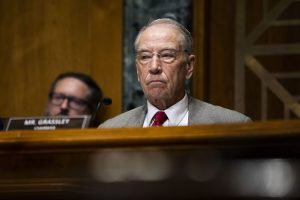 Members of the International Brotherhood of Teamstersprotest in 2016 a plan by the Central States Pension Fundto reduce payments to retirees. Central States is a massivemultiemployer plan that is projected to be insolvent by2025. (Photo: Drew Angerer/Bloomberg)
Members of the International Brotherhood of Teamstersprotest in 2016 a plan by the Central States Pension Fundto reduce payments to retirees. Central States is a massivemultiemployer plan that is projected to be insolvent by2025. (Photo: Drew Angerer/Bloomberg)
Republican lawmakers in the Senate are advancing a proposal torescue collectively bargained multiemployer plans headed towardinsolvency.
|Related: Union pensions: Will Congress kick the can on asolution?
|The Multiemployer Pension Recapitalization and Reform Plan,authored by Sen. Chuck Grassley, R-IA, chair of the Senate FinanceCommittee, and Sen. Lamar Alexander, R-TN, chair of the Health,Education, Labor, and Pensions Committee, takes dramaticallydifferent steps to Democratic-backed legislation that advanced outof the House of Representatives this summer.
|Partitioning orphaned participants
The proposal would partition orphaned participants from the125 multiemployer plans in critical anddeclining status, allowing the original plan to continue payingbenefits with contributions from healthy employers.
| Senator Charles Grassley(R-IA) during a Senate Committee on Finance hearing in 2019.(Photo: Diego M. Radzinschi/ALM)
Senator Charles Grassley(R-IA) during a Senate Committee on Finance hearing in 2019.(Photo: Diego M. Radzinschi/ALM)
Orphaned participants of employers that leave plans degradefunded statuses, according to a white paper explaining the reformproposal.
|"Partitioning is akin to creation of a 'healthy pension' thatcontinues in a healthy fashion and a separate 'sick pension' thatrequires attention and assistance from the PBGC," the proposalsays.
|Raising PBGC premiums
The Pension Benefit Guaranty Corp.'s multiemployer insuranceprogram is running a $65.2 billion deficit, and is projected to beinsolvent in 2025 after two large plans run outof cash.
| Senator Lamar Alexander(R-TN) during a Senate Health, Education, Labor, and PensionsCommittee, 2019. (Photo: Diego M. Radzinschi/ALM)
Senator Lamar Alexander(R-TN) during a Senate Health, Education, Labor, and PensionsCommittee, 2019. (Photo: Diego M. Radzinschi/ALM)
The proposal from Grassley and Alexander woulddramatically raise premiums multiemployer plans pay to PBGC. Underexisting law, all multiemployer plans pay a flat per-head premiumof $29.
|That would be raised to $80 under the proposal, on par withPBGC's single-employer flat rate. The proposal would also introducea variable rate for multiemployer plans that are not fully funded,as is done with single-employer plans.
|And it would broaden the contribution base by requiring amonthly $2.50 co-payment on active workers and most retirees.
|The extra premium revenue and new co-payments would allow PBGCto raise its maximum benefit backstop, which is now just under$13,000 annually.
|Stricter discount rates
Under current law, multiemployer plans have wide latitude inapplying the discount rates that determine future plan liabilities,and in turn determine promised benefits and necessary employercontributions.
|Single-employer plans, however, have strict limitations on thediscount rates applied to plan liabilities, resulting in moreconservative estimates of returns on invested assets.
|The average discount rate assumed by multiemployer plans is 7.13percent, according to the PBGC.
|Under the proposal, the maximum discount rate would be 6percent, and the cap would be phased in over five years to allowplans time to smooth the subsequent increases in contributions.
|The proposal also reforms rules governing the withdrawalliability individual employers pay when they leave plans. Thoseliabilities would be reduced as plan funded levels improve.
|"This crisis is severe and gets worse every day. Around 125multiemployer plans have said they'll become insolvent over thenext two decades. Several large plans—including the big CentralStates Pension Fund—predict they'll go insolvent in the next fewyears. This leaves more than 1.3 million participants without thepension benefits they've been promised, including 10,000 Iowans,"Sen. Grassley said in a statement.
|"We need to act quickly, but we can't just pour money intofailing and mismanaged funds. Our plan will provide relief andreform now, without it our retirees will be left without the futurethey worked for," he added.
|READ MORE:
Complete your profile to continue reading and get FREE access to BenefitsPRO, part of your ALM digital membership.
Your access to unlimited BenefitsPRO content isn’t changing.
Once you are an ALM digital member, you’ll receive:
- Critical BenefitsPRO information including cutting edge post-reform success strategies, access to educational webcasts and videos, resources from industry leaders, and informative Newsletters.
- Exclusive discounts on ALM, BenefitsPRO magazine and BenefitsPRO.com events
- Access to other award-winning ALM websites including ThinkAdvisor.com and Law.com
Already have an account? Sign In
© 2024 ALM Global, LLC, All Rights Reserved. Request academic re-use from www.copyright.com. All other uses, submit a request to [email protected]. For more information visit Asset & Logo Licensing.








